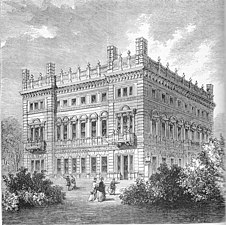
Duke of Sutherland is a title in the Peerage of the United Kingdom which was created by William IV in 1833 for George Leveson-Gower, 2nd Marquess of Stafford. A series of marriages to heiresses by members of the Leveson-Gower family made the dukes of Sutherland one of the richest landowning families in the United Kingdom. The title remained in the Leveson-Gower family until the death of the 5th Duke of Sutherland in 1963, when it passed to the 5th Earl of Ellesmere from the Egerton family.

Earl Granville is a title that has been created twice, once in the Peerage of Great Britain and once in the Peerage of the United Kingdom. It is now held by members of the Leveson-Gower family.

Earl of Ellesmere, of Ellesmere in the County of Shropshire, is a title in the Peerage of the United Kingdom. It was created in 1846 for the Conservative politician Lord Francis Egerton. He was granted the subsidiary title of Viscount Brackley, of Brackley in the County of Northampton, at the same time, also in the Peerage of the United Kingdom. Born Lord Francis Leveson-Gower, he was the third son of George Leveson-Gower, 1st Duke of Sutherland and Elizabeth Gordon, 19th Countess of Sutherland. In 1803 his father had inherited the substantial estates of his maternal uncle Francis Egerton, 3rd Duke of Bridgewater. On his father's death in 1833, Lord Francis succeeded to the Egerton estates according to the will of the late Duke of Bridgewater, and assumed by Royal licence the surname of Egerton in lieu of Leveson-Gower. The Brackley and Ellesmere titles created for him in 1846 were revivals of titles held by the Dukes of Bridgewater. In 1963 his great-great-grandson, the fifth Earl, succeeded his kinsman as 6th Duke of Sutherland. The earldom of Ellesmere and viscountcy of Brackley are now subsidiary titles of the dukedom.

Earl of Bridgewater was a title that has been created twice in the Peerage of England, once for the Daubeny family (1538) and once for the Egerton family (1617). From 1720 to 1803, the Earls of Bridgewater also held the title of Duke of Bridgewater. The 3rd Duke of Bridgewater is famously known as the "Canal Duke", for his creation of a series of canals in North West England.
Francis Ronald Egerton, 7th Duke of Sutherland, known as Francis Ronald Egerton until 2000, is a British peer from the Egerton family.

Francis Egerton, 3rd Duke of Bridgewater, known as Lord Francis Egerton until 1748, was a British nobleman from the Egerton family. He was the youngest son of the 1st Duke. He did not marry, and the dukedom expired with him, although the earldom was inherited by a cousin, Lieutenant-General John Egerton.

Francis Egerton, 1st Earl of Ellesmere,, known as Lord Francis Leveson-Gower until 1833, was a British politician, writer, traveller and patron of the arts. Ellesmere Island, a major island in Nunavut, the Canadian Arctic, was named after him.

John Sutherland Egerton, 6th Duke of Sutherland, was a British peer from the Egerton family. He was styled Viscount Brackley until 1944, when he became the 5th Earl of Ellesmere on inheriting his father's substantive title. He inherited his ducal title in 1963 from a distant cousin.

George Granville Leveson-Gower, 1st Duke of Sutherland KG, PC, known as Viscount Trentham from 1758 to 1786, as Earl Gower from 1786 to 1803 and as the Marquess of Stafford from 1803 to 1833, was an English politician, diplomat, landowner and patron of the arts from the Leveson-Gower family. He was the wealthiest man in Britain during the latter part of his life. He remains a controversial figure for his role in the Highland Clearances.
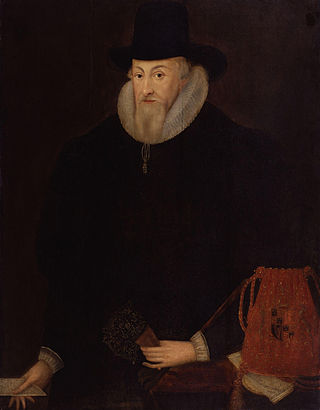
Thomas Egerton, 1st Viscount Brackley,, known as Lord Ellesmere from 1603 to 1616, was an English nobleman, judge and statesman from the Egerton family who served as Lord Keeper and Lord Chancellor for twenty-one years.

John Egerton, 3rd Earl of Bridgewater KB PC was a British nobleman from the Egerton family.

Scroop Egerton, 1st Duke of Bridgewater, styled as Viscount Brackley from 1687 to 1701 and as the Earl of Bridgewater from 1701 to 1720, was an English peer, courtier and landowner. Born into the Egerton family, he succeeded as Earl of Bridgewater in 1701, before being created Duke of Bridgewater on 18 June 1720, with subsidiary titles including Marquess of Brackley.
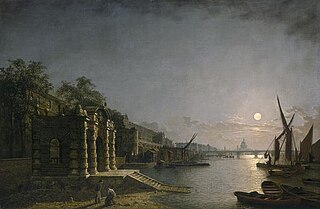
York House was one of a series of grand mansions that formerly stood on the Strand, the principal route from the City of London to the Palace of Westminster.

James Loch was a Scottish advocate, barrister, estate commissioner and later a member of parliament.
Admiral Francis Egerton, known as Francis Leveson-Gower until 1833, was a British naval commander and politician from the Egerton family.

Diana and Callisto is a painting completed between 1556 and 1559 by the Italian late Renaissance artist Titian. It portrays the moment in which the goddess Diana discovers that her maid Callisto has become pregnant by Jupiter. The painting was jointly purchased by the National Gallery and the Scottish National Gallery for £45 million in March 2012. Along with its companion painting Diana and Actaeon it is displayed on an alternating basis between London and Edinburgh. There is a later version by Titian and his workshop in the Kunsthistorisches Museum in Vienna.
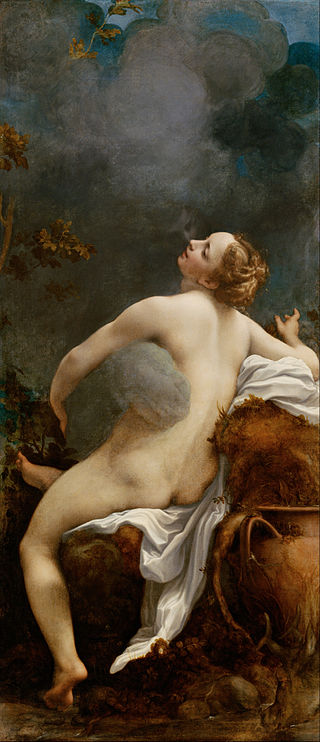
The Orleans Collection was a very important collection of over 500 paintings formed by Philippe II, Duke of Orléans, mostly acquired between about 1700 and his death in 1723. Apart from the great royal-become-national collections of Europe it is arguably the greatest private collection of Western art, especially Italian, ever assembled, and probably the most famous, helped by the fact that most of the collection has been accessible to the public since it was formed, whether in Paris, or subsequently in London, Edinburgh and elsewhere.

Charles I Insulted by Cromwell's Soldiers is an oil painting by the French artist Paul Delaroche, depicting Charles I of England taunted by the victorious soldiers of Oliver Cromwell after the Second English Civil War, prior to his execution in 1649. Completed in 1836, it is thought to be one of Delaroche's greatest masterpieces. It was displayed as part of the Bridgewater Collection in London, although it was latterly thought to have been lost when, during The Blitz of 1941, a German bomb struck close to Bridgewater House, causing shrapnel damage to the canvas in the ensuing explosion. In 2009 it was rediscovered in Scotland in an unexpectedly good condition, having been rolled up and stored after the war, but recorded in the intervening years as badly damaged or destroyed. After a partial restoration it went on display in the National Gallery in London in 2010, in an exhibition re-appraising Delaroche's work. After the exhibition, it was to be fully restored.
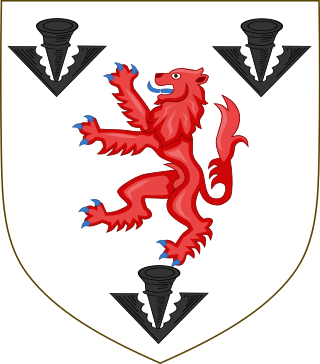
The Egerton family is a British aristocratic family. Over time, several members of the Egerton family were made Dukes, Earls, knights, baronets and peers. Hereditary titles held by the Egerton family include the dukedoms of Bridgewater (1720–1803) and Sutherland, as well as the earldoms of Bridgewater (1617–1829), Wilton (1801–1999) and Egerton (1897–1909). Several other members of the family have also risen to prominence. The Egerton family motto is Virtuti non armis fido.
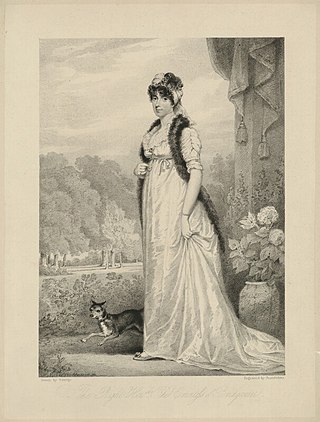
Charlotte Catherine Anne, Countess of Bridgewater, née Charlotte Haynes, was a British noblewoman. She was known for her philanthropic and charitable acts, and supported numerous educational and religious causes. She was responsible for the laying out of the ornamental gardens around her family home at Ashridge in Hertfordshire.



